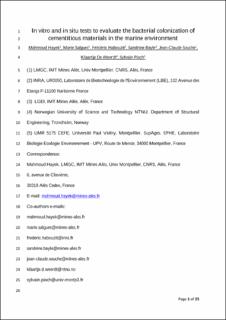| dc.contributor.author | Hayek, Mahmoud | |
| dc.contributor.author | Salgues, Marie | |
| dc.contributor.author | Habouzit, Frédéric | |
| dc.contributor.author | Bayle, Sandrine | |
| dc.contributor.author | Souche, Jean-Claude | |
| dc.contributor.author | De Weerdt, Klaartje | |
| dc.contributor.author | Pioch, Sylvain | |
| dc.date.accessioned | 2021-10-22T07:28:07Z | |
| dc.date.available | 2021-10-22T07:28:07Z | |
| dc.date.created | 2021-03-24T16:44:34Z | |
| dc.date.issued | 2020 | |
| dc.identifier.citation | Cement & Concrete Composites. 2020, 113 1-11. | en_US |
| dc.identifier.issn | 0958-9465 | |
| dc.identifier.uri | https://hdl.handle.net/11250/2824874 | |
| dc.description.abstract | Civil engineers have a responsibility to take measures to protect marine biodiversity by selecting more bioreceptive construction materials in the design of marine infrastructure, for better biodiversity conservation. In this study, it was shown that pre-carbonation of cementitious materials accelerates their bacterial colorization by lowering the pH of their surface. It has been shown both in the laboratory and in-situ tests that the bacterial colonization of cementitious materials is influenced by the pH and the type of cement. By comparing the bacterial colonization of Portland cement mortars, CEM I, and slag cement, CEM III, mortars, it was found that the CEM III mortars are more bioreceptive than the CEM I mortars. This study presented and verified a novel experimental laboratory approach which can be used to evaluate the bacterial colonization (bioreceptivity) of cementitious materials in marine environment. The approach could be taken up in future recommendations to enable engineers to eco-design more eco-friendly marine infrastructure and develop green-engineering projects. | en_US |
| dc.language.iso | eng | en_US |
| dc.publisher | Elsevier | en_US |
| dc.rights | Navngivelse 4.0 Internasjonal | * |
| dc.rights | Attribution-NonCommercial-NoDerivatives 4.0 Internasjonal | * |
| dc.rights.uri | http://creativecommons.org/licenses/by-nc-nd/4.0/deed.no | * |
| dc.title | In vitro and in situ tests to evaluate the bacterial colonization of cementitious materials in the marine environment | en_US |
| dc.type | Peer reviewed | en_US |
| dc.type | Journal article | en_US |
| dc.description.version | acceptedVersion | en_US |
| dc.rights.holder | This is the authors' accepted manuscript to an article published by Elsevier. Locked until 24.7.2022 due to copyright restrictions. The AAM is made available under the CC-BY-NC-ND 4.0 license http://creativecommons.org/licenses/by-nc-nd/4.0/ | en_US |
| dc.source.pagenumber | 1-11 | en_US |
| dc.source.volume | 113 | en_US |
| dc.source.journal | Cement & Concrete Composites | en_US |
| dc.identifier.doi | 10.1016/j.cemconcomp.2020.103748 | |
| dc.identifier.cristin | 1900796 | |
| cristin.ispublished | true | |
| cristin.fulltext | postprint | |
| cristin.qualitycode | 1 | |

